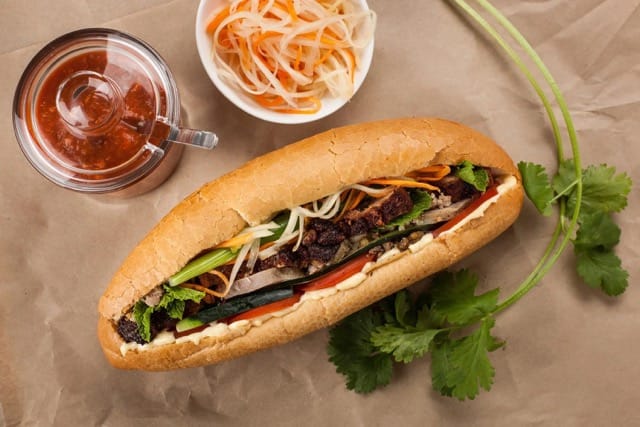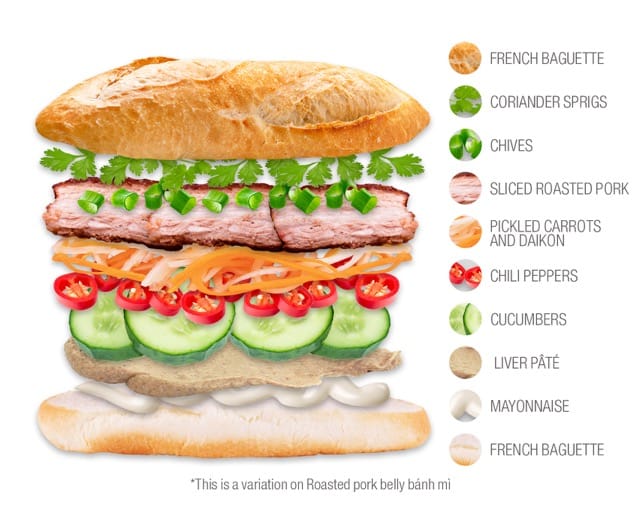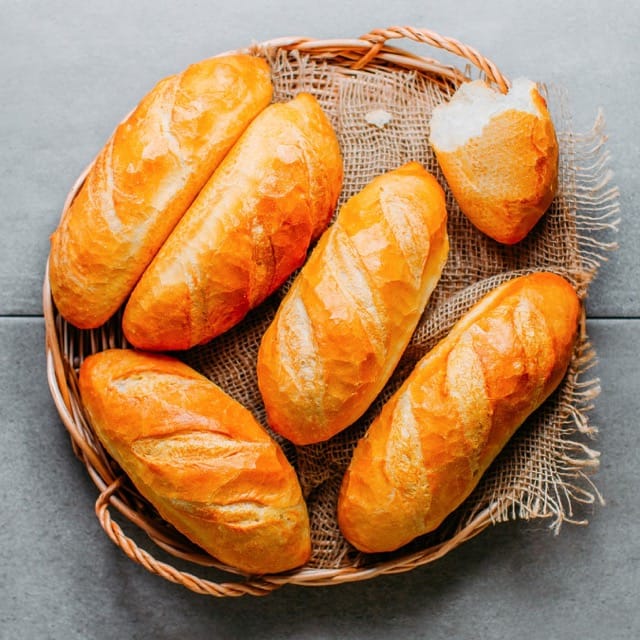In this article, let’s discover the magic of Vietnamese bread, or Bánh Mì. It’s a cherished culinary delight in Vietnam, deeply rooted in the culture. We’ll take you on a journey through its history, ingredients, and the best places to savor it. Let’s dive into the world of Bánh Mì!
See more: Embracing Vietnamese Cuisine – A Vibrant Culinary Adventure
Contents
Exploring the Vietnamese Bread
Vietnamese cuisine boasts a rich tapestry of flavors and dishes, but few are as emblematic as Bánh Mì, the beloved Vietnamese bread.
What is Vietnamese Bread?
The word “Bánh Mì” itself is a testament to this blend, where “Bánh” means bread in Vietnamese, while “Mì” in Vietnamese refers to wheat, which is the key ingredient in the French baguette. This amalgamation encapsulates the harmonious coexistence of two cultures.
Beyond its French influence, the evolution of Bánh Mì was also shaped by the availability of local ingredients in Vietnam. Regional variations emerged as different parts of Vietnam incorporated their unique herbs, meats, and condiments, resulting in distinct Bánh Mì experiences. For instance, Saigon’s Bánh Mì differs from those in Hanoi due to variations in local ingredients and tastes.

A Culinary Icon in Vietnamese
Bánh Mì is more than just a culinary creation; it’s deeply embedded in Vietnamese culture and society. Here’s a glimpse of its significance:
- Versatility: Bánh Mì is adaptable and versatile. It can be enjoyed at any time of the day and serves as both a quick snack and a hearty meal. Its adaptability makes it a staple in the daily lives of the Vietnamese.
- Accessible to All: What sets Bánh Mì apart is its accessibility. You can find it everywhere in Vietnam, from street food stalls to high-end restaurants. It’s a symbol of affordability, offering a delicious and filling option for everyone.
- Culinary Heritage: Bánh Mì is part of Vietnam’s culinary heritage, and it reflects the resourcefulness and creativity of Vietnamese cooks. The filling variations and accompaniments cater to diverse tastes and preferences.
Savor Divine Vietnamese Cream Puffs: An Irresistible Indulgence.
Regional Variations of Bánh Mì
Bánh Mì, with its regional adaptations, showcases the diverse flavors of Vietnam:
- Saigon Bánh Mì (Bánh Mì Sài Gòn): In Ho Chi Minh City, or Saigon, you’ll savor Bánh Mì bursting with grilled meats like beef and pork, accompanied by fresh herbs, pickled veggies, and a medley of sauces, creating a flavor explosion.
- Hanoi Bánh Mì (Bánh Mì Hà Nội): Up in Hanoi, you’ll discover a simpler Bánh Mì, with fewer herbs and traditional, milder seasonings, reflecting the northern capital’s culinary tradition.
Bánh Mì Ingredients and Variations
While variations are numerous, the core elements of a traditional Bánh Mì include:
- Baguette: The foundation of Bánh Mì is the French baguette, a long and crusty bread. Its crispy exterior and soft interior create the perfect canvas for the fillings.
- Proteins: Bánh Mì can feature a variety of proteins. Grilled pork (Bánh Mì thịt nướng), shredded chicken (Bánh Mì gà), and meatballs (Bánh Mì xíu mại) are some popular options. Each protein brings its unique taste and texture.
- Herbs and Vegetables: Fresh herbs and vegetables are vital for the characteristic crunch and freshness of Bánh Mì. Cilantro, cucumber, and pickled daikon and carrots are common choices. These elements balance the rich proteins.
- Condiments and Sauces: A combination of sauces is used, typically including mayonnaise, pâté, and a variety of hot sauces. The condiments add a creamy, spicy, and umami-rich dimension to the sandwich.

A Traditional Vietnamese Bread Has Many Layers – Source: Internet
For those seeking plant-based alternatives, the world of vegetarian and vegan Bánh Mì offers a delectable array of options. These options align with dietary preferences and maintain the vibrant flavors of the traditional Bánh Mì:
- Tofu and Tempeh: Marinated and grilled tofu or tempeh can effectively replace meat in Bánh Mì. These plant-based proteins absorb flavors well and provide a satisfying texture.
- Mushrooms: Mushrooms, especially shiitake or king oyster mushrooms, are a popular choice for their meaty texture and umami taste. They’re often marinated and pan-fried before being added to the sandwich.
- Vegan Mayonnaise: Substituting traditional mayonnaise with vegan mayo maintains the creaminess of the Bánh Mì. Many vegan mayos are available in stores and can be used to enhance the taste.
- Eggless Pâté: Eggless pâté made from lentils, beans, or nuts provides a similar creamy and savory flavor profile as traditional pâté.

Vegan Banh Mi Is Tasty – Source: Internet
Where to Find the Best Bánh Mì in Vietnam
For the best Bánh Mì in Vietnam, explore street stalls for an authentic and mouth watering experience. Street vendors across the country offer a wide variety of Bánh Mì options, each with its unique twist and local flair. Whether you’re in Hanoi, Ho Chi Minh City, Hoi An, Da Nang, or Nha Trang, the streets are your culinary playground to discover these iconic sandwiches.
Local markets in Vietnam offer a budget-friendly yet delicious way to enjoy Bánh Mì. While exploring these markets, you’ll find numerous stalls serving this beloved sandwich. It’s a wonderful opportunity to savor Bánh Mì while immersing yourself in the vibrant atmosphere of local life. Some recommended local markets include those in Ho Chi Minh City, Hanoi, Hoi An, and Da Lat, where you can relish diverse fillings and toppings in a cultural setting.
Delve into the Rich Taste of Vietnam: A Culinary Odyssey
How to Make Grilled Pork Bánh Mì at Home
Step-By-Step Recipe
Bánh Mì with grilled pork is a classic and delicious choice. Here’s a step-by-step guide to creating this Vietnamese sandwich in your own kitchen:
Ingredients You’ll Need:
- Baguette or Bánh Mì
- Grilled pork (see marinating recipe below)
- Fresh herbs and vegetables (cilantro, cucumber, pickled daikon and carrots)
- Condiments (mayonnaise, pâté, hot sauce, soy sauce)
- Optional extras (sliced jalapeños, fried shallots)
Marinating the Grilled Pork.
Ingredients for Pork Marinade:
- 1 pound of pork shoulder, thinly sliced
- 3 cloves of garlic, minced
- 2 stalks of lemongrass, finely chopped
- 2 tablespoons of fish sauce
- 1 tablespoon of sugar
- 1 tablespoon of vegetable oil
- 1 teaspoon of black pepper
Step 1: Marinate the Pork:
- In a bowl, combine the minced garlic, chopped lemongrass, fish sauce, sugar, vegetable oil, and black pepper to create the marinade.
- Place the thinly sliced pork in a resealable plastic bag or a shallow dish.
- Pour the marinade over the pork, ensuring that the slices are well-coated.
- Seal the bag or cover the dish and refrigerate for at least 30 minutes, allowing the flavors to infuse the meat.
Step 2: Grilling the Pork:
- Preheat your grill to medium-high heat or use a grill pan on your stovetop.
- Remove the marinated pork from the refrigerator and let it come to room temperature for about 15 minutes.
- Thread the pork slices onto skewers or place them directly on the grill grates.
- Grill the pork for approximately 2-3 minutes on each side, or until it’s fully cooked and has a slight char.
Step 3: Assembling the Bánh Mì:
- Slice the French baguette or Bánh Mì roll lengthwise, without cutting all the way through.
- Spread a layer of pâté on one side of the bread and mayonnaise on the other.
- Place the grilled pork on one side of the bread, evenly distributing the slices.
- Add fresh herbs and vegetables such as cilantro, cucumber, and pickled daikon and carrots to the sandwich.
- Drizzle soy sauce and a dash of hot sauce for extra flavor.
- For added zest, consider adding sliced jalapeños and a sprinkle of fried shallots.
Step 4: Folding and Enjoying:
Gently press the sandwich together, giving it a slight squeeze to compact it without making it too dense. The ideal Bánh Mì is a balance of flavors and textures. And there you have it – a delectable homemade Grilled Pork Bánh Mì that’s sure to satisfy your culinary cravings!

Cooking Tips
- Choose the Right Bread: The choice of bread is vital. Look for a baguette that has a crispy crust and a soft, airy interior.

A Right Banh Mi Must Have Crunchy Crust – Source: Internet - Marinating Meat: Marinate the proteins (pork/beef/gluten) for at least 30 minutes to infuse them with flavor. The marinades often include a mix of lemongrass, fish sauce, soy sauce, sugar, and garlic.
- Fresh Ingredients: Use fresh herbs and vegetables for a burst of flavor and crunch. Cilantro, cucumber, and pickled daikon and carrots are common choices.
- Condiments: Don’t skimp on condiments. The combination of pâté, mayonnaise, and hot sauce adds creaminess and depth of flavor.
- Balanced Flavors: Achieving the perfect Bánh Mì is all about balance. You want a combination of sweet, salty, spicy, and savory flavors.
- Customization: Bánh Mì is highly customizable. Feel free to experiment with fillings, sauces, and toppings to create your perfect Vietnamese bread.
Indulge in Vietnam’s Finest Sweets: A Journey Through Sweet Memories
Conclusion
Vietnamese bread, or Bánh Mì, is a culinary treasure, reflecting the country’s rich flavors and culture. We encourage travelers to savor this iconic sandwich in Vietnam. From street stalls to local markets, it’s a delightful journey of taste and tradition waiting to be explored.
Frequently about Vietnamese Bread (Bánh Mì)
Q1: How to Make Vietnamese Bread (Bánh Mì)?
A1: To make Vietnamese Bánh Mì, you’ll need a French baguette or Bánh Mì roll, protein (like grilled pork or tofu), fresh herbs and vegetables, condiments (mayonnaise, pâté, hot sauce, soy sauce), and optional extras. Marinate and grill the protein, assemble the sandwich, and enjoy!
Q2: Where to Buy Vietnamese Bread Rolls?
A2: You can buy Vietnamese bread rolls at local bakeries, street stalls, and markets in Vietnam. These rolls are widely available and a key ingredient for Bánh Mì.
Q3: How to Say “Bread” in Vietnamese?
A3: In Vietnamese, “bread” is pronounced as “bánh mì.” It’s the same term used for the iconic Vietnamese sandwich, making it easy to remember.


Related Posts
Saigon’s “Flower Market Replica”: Where To Find Them
Ho Chi Minh City’s floral charm is not limited to its bustling wholesale markets. Imagine wandering through a place where vibrant petals, fragrant blooms, and the spirit of traditional Vietnamese markets come alive—without the overwhelming crowds. A flower market replica captures that magic, blending the beauty of fresh flowers with the charm of a curated, […]
Is it Safe to Travel to Vietnam Right Now? A Complete 2025 Guide
Vietnam has emerged as one of Southeast Asia’s most captivating destinations, drawing millions of visitors annually with its rich culture, stunning landscapes, and incredible cuisine. However, many travelers still ask: Is it safe to travel to Vietnam right now? This comprehensive guide provides you with everything you need to know about Vietnam travel safety in […]
Ho Chi Minh Cu Chi Tunnels Tour: The Ultimate Guide
The Cu Chi Tunnels stand as one of Vietnam’s most remarkable historical sites, offering visitors a profound glimpse into the ingenuity and resilience displayed during the Vietnam War. For travelers, a Ho Chi Minh Cu Chi tunnels tour represents an essential experience that combines education, adventure, and deep cultural understanding. This comprehensive guide will help […]